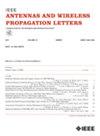可设计凹深度的3d打印单馈45°极化波导天线
IF 4.8
2区 计算机科学
Q2 ENGINEERING, ELECTRICAL & ELECTRONIC
引用次数: 0
摘要
本文介绍了一种x波段45°偏振形波束天线,该天线采用金属3d打印实现了可设计的凹深度。关键创新包括:提出了一种双波导天线孔径,可以通过叠加差和模式来控制凹深度;设计了一种紧凑的波导功率分压器,可以提供两个波导孔径之间所需的幅度比和相位差,有效地调节差和波束模式之间的模式比。辐射波导在不改变相位中心的情况下扭曲45°,实现45°极化。利用金属3d打印技术制作了3个不同凹形深度的原型,并进行了实验验证。在8.4 GHz ~ 9.4 GHz工作频段内,分别实现了−5.6 ~−6.9 dB、−7.9 ~−9.1 dB和−12.2 ~−13 dB的模式凹深度,相应增益大于6.2 dBi,反射系数小于−12 dB,交叉极化电平小于−15 dB。这项工作提供了一种有前途的45°极化天线解决方案,该天线具有定制波束覆盖和相应阵列实现所需的可设计方向凹。本文章由计算机程序翻译,如有差异,请以英文原文为准。
3-D-Printed Single-Feed 45°-Polarized Waveguide-Based Antenna With Designable Concave Depth
This letter presents an X-band 45° polarization shaped beam antenna with designable concave depth implemented using metal 3-D printing. The key innovations include: A dual-waveguide antenna aperture enabling concave depth control via superposition of difference and sum patterns is proposed, and a compact waveguide power divider is designed to provide the desired amplitude ratio and phase difference between the two waveguide apertures, effectively adjusting the mode ratio between the difference and sum beam patterns. The radiating waveguides are twisted by 45° without changing phase centers to realize 45° polarization. Three prototypes with different pattern concave depths are fabricated using metal 3-D printing and experimentally verified. Within the operating band from 8.4 GHz to 9.4 GHz, the pattern concave depths of −5.6 dB to −6.9 dB, −7.9 dB to −9.1 dB, and −12.2 dB to −13 dB are realized, respectively, with corresponding gains higher than 6.2 dBi, reflection coefficients below −12 dB and cross-polarization levels below −15 dB. This work provides a promising solution of 45°-polarized antenna with a designable pattern concave required by customized beam coverage and corresponding array implementations.
求助全文
通过发布文献求助,成功后即可免费获取论文全文。
去求助
来源期刊
CiteScore
8.00
自引率
9.50%
发文量
529
审稿时长
1.0 months
期刊介绍:
IEEE Antennas and Wireless Propagation Letters (AWP Letters) is devoted to the rapid electronic publication of short manuscripts in the technical areas of Antennas and Wireless Propagation. These are areas of competence for the IEEE Antennas and Propagation Society (AP-S). AWPL aims to be one of the "fastest" journals among IEEE publications. This means that for papers that are eventually accepted, it is intended that an author may expect his or her paper to appear in IEEE Xplore, on average, around two months after submission.

 求助内容:
求助内容: 应助结果提醒方式:
应助结果提醒方式:


